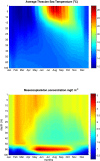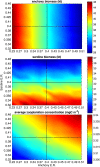Development, application and evaluation of a 1-D full life cycle anchovy and sardine model for the North Aegean Sea (Eastern Mediterranean)
- PMID: 31415572
- PMCID: PMC6695132
- DOI: 10.1371/journal.pone.0219671
Development, application and evaluation of a 1-D full life cycle anchovy and sardine model for the North Aegean Sea (Eastern Mediterranean)
Abstract
A 1-D full-life-cycle, Individual-based model (IBM), two-way coupled with a hydrodynamic/biogeochemical model, is demonstrated for anchovy and sardine in the N. Aegean Sea (Eastern Mediterranean). The model is stage-specific and includes a 'Wisconsin' type bioenergetics, a diel vertical migration and a population dynamics module, with the incorporation of known differences in biological attributes between the anchovy and sardine stocks. A new energy allocation/egg production algorithm was developed, allowing for breeding pattern to move along the capital-income breeding continuum. Fish growth was calibrated against available size-at-age data by tuning food consumption (the half saturation coefficients) using a genetic algorithm. After a ten-years spin up, the model reproduced well the magnitude of population biomasses and spawning periods of the two species in the N. Aegean Sea. Surprisingly, model simulations revealed that anchovy depends primarily on stored energy for egg production (mostly capital breeder) whereas sardine depends heavily on direct food intake (income breeder). This is related to the peculiar phenology of plankton production in the area, with mesozooplankton concentration exhibiting a sharp decrease from early summer to autumn and a subsequent increase from winter to early summer. Monthly changes in somatic condition of fish collected on board the commercial purse seine fleet followed closely the simulated mesozooplankton concentration. Finally, model simulations showed that, when both the anchovy and sardine stocks are overexploited, the mesozooplankton concentration increases, which may open up ecological space for competing species. The importance of protecting the recruit spawners was highlighted with model simulations testing the effect of changing the timing of the existing 2.5-months closed period. Optimum timing for fishery closure is different for anchovy and sardine because of their opposite spawning and recruitment periods.
Conflict of interest statement
The authors have declared that no competing interests exist.
Figures











Similar articles
-
Anchovy and sardine condition and energy content in the North Aegean Sea (eastern Mediterranean) in relation to their contrasting reproductive strategies.J Fish Biol. 2024 Oct;105(4):1178-1188. doi: 10.1111/jfb.15872. Epub 2024 Jul 19. J Fish Biol. 2024. PMID: 39031973
-
Year-round energy dynamics of sardine and anchovy in the north-western Mediterranean Sea.Mar Environ Res. 2020 Jul;159:105021. doi: 10.1016/j.marenvres.2020.105021. Epub 2020 May 20. Mar Environ Res. 2020. PMID: 32662445
-
Fatty acid composition and parasitism of European sardine (Sardina pilchardus) and anchovy (Engraulis encrasicolus) populations in the northern Catalan Sea in the context of changing environmental conditions.Conserv Physiol. 2020 Dec 29;8(1):coaa121. doi: 10.1093/conphys/coaa121. eCollection 2020. Conserv Physiol. 2020. PMID: 33408866 Free PMC article.
-
Direct and ancillary benefits of ecosystem-based fisheries management in forage fish fisheries.Ecol Appl. 2021 Oct;31(7):e02421. doi: 10.1002/eap.2421. Epub 2021 Aug 30. Ecol Appl. 2021. PMID: 34288221 Free PMC article.
-
Energy content of anchovy and sardine using surrogate calorimetry methods.Mar Environ Res. 2021 Dec;172:105510. doi: 10.1016/j.marenvres.2021.105510. Epub 2021 Oct 23. Mar Environ Res. 2021. PMID: 34717130
References
-
- Checkley DM Jr., Bakun A, Barange M, Castro LR, Freon P, Guevara R, Herrick SF Jr., McCall AD, Ommer R, Oozeki Y, Roy C, Shannon L, Van der Lingen CD. 2009. Synthesis and perspective. Climate change and small pelagic fish. (Checkley DM Jr., Alheit J, Oozeki Y, Roy C, Eds.).:344–351., Cambridge, UK; New York: Cambridge University Press
-
- Alheit J., Roy C., & Kifani S. (2009). Decadal-scale variability in populations In Checkley D., Alheit J., Oozeki Y., & Roy C. (Eds.), Climate Change and Small Pelagic Fish (pp. 64–87). Cambridge: Cambridge University Press; 10.1017/CBO9780511596681.007 - DOI
-
- Checkley D., Asch R. and Rykaczewski R. (2017). Climate, Anchovy, and Sardine. Annual Review of Marine Science, 9(1), pp.469–493. - PubMed
-
- Bakun A., Babcock E.A., Lluch-Cota S.E., Santora C., Salvadeo C.J. 2010. Issues of ecosystem-based management of forage fisheries in ‘‘open” non-stationary ecosystems: the example of the sardine fishery in the Gulf of California. Rev Fish Biol Fisheries 20: 9–29.
-
- Pikitch, E., Boersma, P.D., Boyd, I.L., Conover, D.O., Cury, P., Essington, T., et al, 2012. Little fish, big impact: managing a crucial link in ocean food webs. In: Lenfest Ocean Program, Washington, DC, p. 108.
Publication types
MeSH terms
LinkOut - more resources
Full Text Sources

